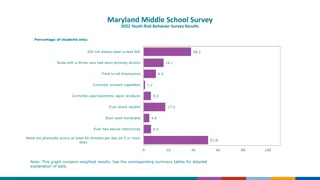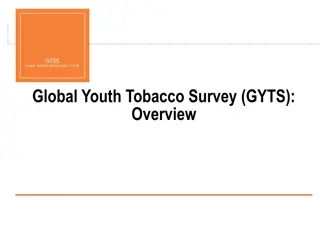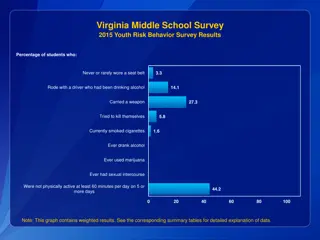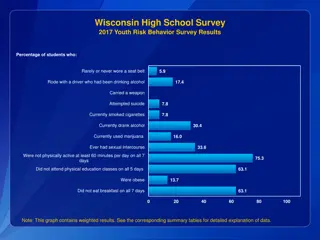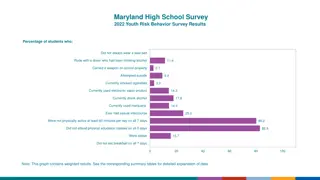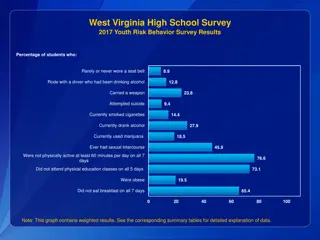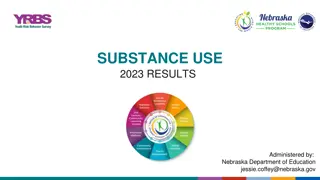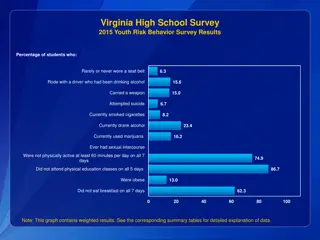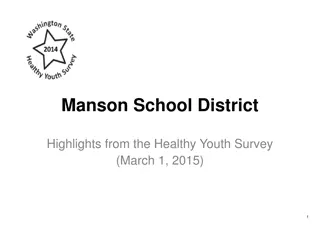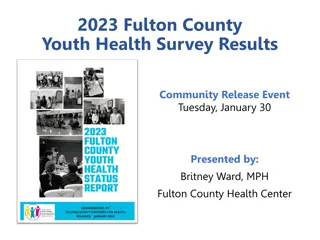Indiana High School Survey 2015 Youth Risk Behavior Results
The Indiana High School Survey 2015 provides valuable insights into the risk behaviors of high school students in Indiana. The survey results reveal concerning percentages of students who engage in behaviors such as not wearing seat belts, riding with drivers who have consumed alcohol, carrying weapons, attempting suicide, smoking cigarettes, using marijuana, and more. The data also highlights positive behaviors such as those who wear seat belts, do not ride with intoxicated drivers, do not carry weapons, and are physically active. It underscores the importance of promoting healthy behaviors and addressing risky behaviors among high school students in Indiana.
Download Presentation

Please find below an Image/Link to download the presentation.
The content on the website is provided AS IS for your information and personal use only. It may not be sold, licensed, or shared on other websites without obtaining consent from the author.If you encounter any issues during the download, it is possible that the publisher has removed the file from their server.
You are allowed to download the files provided on this website for personal or commercial use, subject to the condition that they are used lawfully. All files are the property of their respective owners.
The content on the website is provided AS IS for your information and personal use only. It may not be sold, licensed, or shared on other websites without obtaining consent from the author.
E N D
Presentation Transcript
Indiana High School Survey 2015 Youth Risk Behavior Survey Results Percentage of students who: Rarely or never wore a seat belt 5.9 Rode with a driver who had been drinking alcohol 17.9 Carried a weapon 19.6 Attempted suicide 9.9 Currently smoked cigarettes 11.2 Currently drank alcohol 30.5 Currently used marijuana 16.4 Ever had sexual intercourse 41.7 Were not physically active at least 60 minutes per day on all 7 days 74.7 Did not attend physical education classes on all 5 days 72.0 Were obese 13.6 Did not eat breakfast on all 7 days 69.9 0 20 40 60 80 100 Note: This graph contains weighted results. See the corresponding summary tables for detailed explanation of data.
Indiana High School Survey 2015 Youth Risk Behavior Survey Results Percentage of students who: Sometimes, most of the time, or always wore a seat belt 94.1 Did not ride with a driver who had been drinking alcohol 82.1 Did not carry a weapon 80.4 Did not attempt suicide 90.1 Did not currently smoke cigarettes 88.8 Did not currently drink alcohol 69.5 Did not currently use marijuana 83.6 Never had sexual intercourse 58.3 Were physically active at least 60 minutes per day on all 7 days 25.3 Attended physical education classes on all 5 days 28.0 Were not obese 86.4 Ate breakfast on all 7 days 30.1 0 20 40 60 80 100 Note: This graph contains weighted results. See the corresponding summary tables for detailed explanation of data.
Indiana High School Survey 2015 Youth Risk Behavior Survey Results Number of students in a class of 30 who: Rarely or never wore a seat belt 1.8 Rode with a driver who had been drinking alcohol 5.4 Carried a weapon 5.9 Attempted suicide 3.0 Currently smoked cigarettes 3.4 Currently drank alcohol 9.2 Currently used marijuana 4.9 Ever had sexual intercourse 12.5 Were not physically active at least 60 minutes per day on all 7 days 22.4 Did not attend physical education classes on all 5 days 21.6 Were obese 4.1 Did not eat breakfast on all 7 days 21.0 0 10 20 30 Note: This graph contains weighted results. See the corresponding summary tables for detailed explanation of data.
Indiana High School Survey 2015 Youth Risk Behavior Survey Results Number of students in a class of 30 who: Sometimes, most of the time, or always wore a seat belt 28.2 Did not ride with a driver who had been drinking alcohol 24.6 Did not carry a weapon 24.1 Did not attempt suicide 27.0 Did not currently smoke cigarettes 26.6 Did not currently drink alcohol 20.9 Did not currently use marijuana 25.1 Never had sexual intercourse 17.5 Were physically active at least 60 minutes per day on all 7 days 7.6 Attended physical education classes on all 5 days 8.4 Were not obese 25.9 Ate breakfast on all 7 days 9.0 0 10 20 30 Note: This graph contains weighted results. See the corresponding summary tables for detailed explanation of data.









